2022-11-15
The variety of cat food brands on the market, supplements, and nutritional options make it harder for cat parents to choose the right food and diet for their feline friends. Providing your cat with the nutrients he/she needs and the right diet based on his/her age, breed and health is essential for his/her proper development and general well-being. Considering the importance of the right nutrients for our paw friends’ health, we would like to give you more detailed information in regard to this matter and also provide some tips on how to healthy feed your cat.
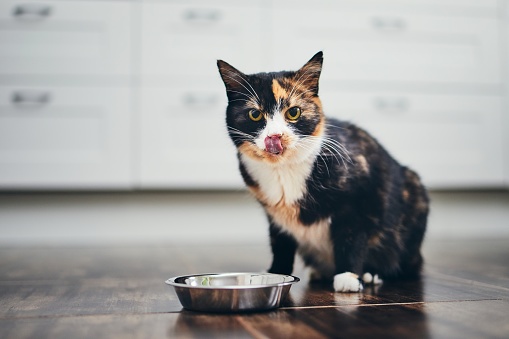
Nutrients that are Important for Cats
Nutrients are divided into 6 groups: Vitamin; Mineral; Fat; Protein; Carbohydrate; Water. You will need to know the proportions in which the nutritional groups listed above should be featured in your cat’s diet.
Vitamins are plant-based or animal-based substances, that are essential for the proper functioning of the body. They support the body’s growth and boost the immune system. Specific functions of vitamins are:
It supports bone structure, tooth growth, reproductive function, vision, and skin.
B vitamins are: thiamine, riboflavin, niacin, pantothenic acid, pyridoxine, biotin, folic acid, cobalamin. They contribute to the normal functioning of vision, improve appetite, help prevent fetal malformations during pregnancy, also help in protein and fat metabolism.
Giving your cat vitamin C is a bit controversial. Although it is a powerful antioxidant with many benefits for us humans, and we need it in our diet, many species, including cats, synthesize vitamin C in the liver. This means that you do not need to feature vitamin C in your feline friend’s diet. However, in some cases, your vet may recommend giving your cat vitamin C, but you need to check with them first.
It is responsible for maintaining phosphorous and calcium that supports bone structure and growth.
It is an antioxidant, that is essential for your cat’s health. Furthermore, it is very beneficial for your cat's skin and proven effective in treating eczema, mites, and flea allergy dermatitis.
It supports normal blood clotting.
When talking about vitamin supplements in general, we would recommend that you do not provide your feline friend with such, as long as he/she receives all the needed vitamins from his/her regular food. You may want to consult your cat’s vet in regard to adding vitamins to his/her food. Otherwise, you may cause more damage than good to your kitty’s nutritional diet.
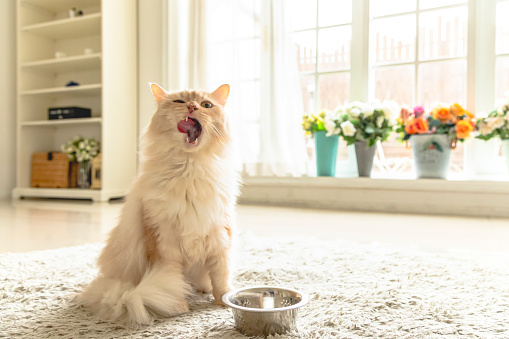
Minerals are inorganic compounds (most do not contain carbon) that are essential for properly running all the physiological reactions in cats. Some important functions that minerals have are transporting oxygen, supporting enzyme build-up, regulating tissue structure, keeping pH balance, supporting skeletal growth, nerve function, heart rhythm...etc.
Minerals feature:
Potassium, Chlorine, Sodium, Calcium, Phosphorus, Magnesium, Iron, Zinc, Manganese, Copper, Iodine, Chromium, Molybdenum, Selenium, and Cobalt.
Cat food that includes cereals, meat, fish, and liver is considered a good mineral source. There are the so-called chelated minerals, which are considered easier to absorb than nonchelated ones. However, this is not always the case. Also, easier absorption is not always recommended. There is a maximum level of minerals that cats should absorb, so getting over it may lead to unwanted effects such as toxicity. You should consult your veterinarian in regard to the maximum mineral intake for your cat.
Fat provides important fatty acids, essential for the body to function properly. Certain types of vitamins such as vitamin A, D, and E are fat-soluble, which means that they can be absorbed through fats only. Fat is a great source of energy for the body and fatty acids such as omega-3 and omega-6 are essential for maintaining your paw friend’s skin and coat. They also help cats heal faster.
Cat food rich in fat usually contains liver, beef, salmon, or chicken. It is recommended that cat food contains 20-24% fat. It's important that also protein content is high in order for the diet to be high quality. If your paw friend is highly energetic, he/she is likely to need food that is higher in fat to provide more energy. However, you should be careful with the fat content of your cat’s food, as high amounts of fat can cause your paw friend to gain weight. Obesity in pets has a very negative impact on their health in the long term.
Dry skin, lack of energy, growth issues, and predisposition to infection are among the symptoms that indicate fat deficiency.
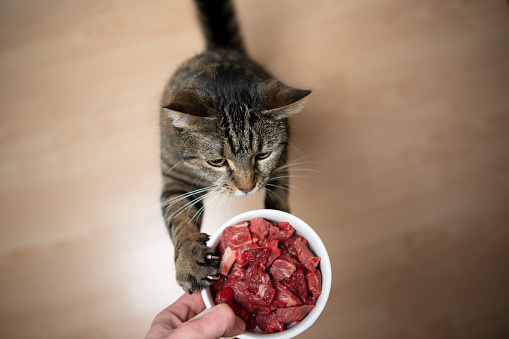
Proteins are made of hundreds of thousands of amino acids, which are the main source of energy for cats. Protein is responsible for many body processes such as muscle development, maintaining fur, skin, nails, antibodies, enzymes, hormones...etc. Protein can be broken down into two types: plant-based and animal-based. Cats absorb most essential amino acids from sources that provide animal protein. In the wild, cats eat the bones, organs, and carcasses of their prey. Amino acids considered essential for cats are:
Arginine, Taurine, Isoleucine, Histidine, Lysine, Leucine, Threonine, Valine, Tryptophan, Methionine, Phenylalanine.
Those of you who are both cat and dog parents may be interested to know that cats, compared to dogs, require food that is higher in protein.
The Association of American Feed Control Officials (AAFCO) recommends for cats that are in the “growth and reproduction” stage a minimum of 30% protein content in their diet, while for adult cats that percentage is 26%.
Carbohydrates are a group of organic compounds, that can be found in food and living tissues such as cellulose, sugars, and starch. Along with fats and protein, carbohydrates, also known as “carbs”, are one of the main nutrients in food and drinks. For humans, as well as for many animals the energy that is being produced by carbs is essential for the normal functioning of some organs.
However, this is not really the case with cats... Their main source of energy are fats and protein. In most cases, a healthy cat will need no more than 10% of his/her his/her calories to come from carbs. If your vet prescribes your cat a diet that is lower in carbs, you may need to make a transition from dry food to wet food. Dry food is richer in carbs (rice, cornmeal, grains), as these are needed for kibble to keep its form. Also, some cats can be allergic to food that is high in carbohydrates. Of course, this does not mean that your cat can not be allergic to certain types of meat such as fish, chicken, or beef. About 10-15% of cats are likely to develop gastrointestinal issues, including symptoms of vomiting and diarrhea, due to meat protein allergy.
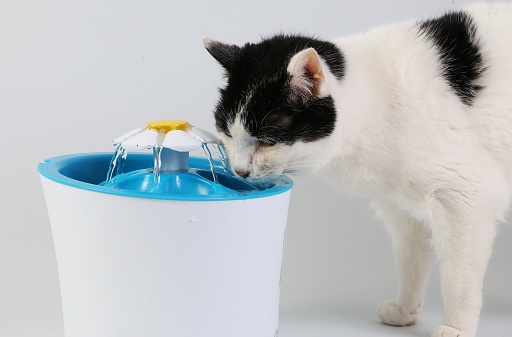
We all know that water is essential for all processes in our body to normally function. However, cat parents may have noticed that their feline friend is not really a water seeker. The process of evolution that cats have gone through, made them gain most of the needed water through their food and not through drinking water. An interesting fact is that cats are more likely to get dehydrated compared to dogs. Since wet food is richer in water than dry food, as the name implies, it is preferred by cats as a water source. As a general rule, cats’ daily water income should be about 4 ounces of water per 5 pounds of body weight. If you feed your feline friend mainly wet food, additional water intake will be much less.
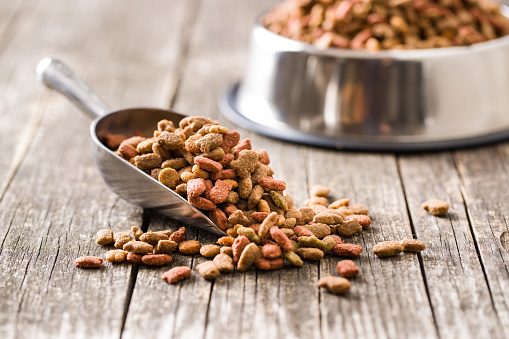
During their early life stage, typically the first month of their life, kittens receive the needed nutrients from their mother’s milk. In case the kittens have been separated from their mother, they should be fed a milk replacer every 2-4 hours.
For kittens who are 4-5 weeks old, you can start providing the milk replacer in a dish (shallow) so they get weaned off a bottle. Also, you can start adding wet food and gradually move to mixed food that includes both moist food and dry food. Food for kittens is high in fat and protein, as kittens need a lot of energy to properly develop. However, you should not overfeed your kitty and feed it in healthy amounts. Your kitty’s veterinarian will give you accurate advice on what type of food and portions you should feed your kitten.
Both wet and dry food have their advantages and disadvantages. The carbs content in certain dry food brands might be higher than the recommended one for your feline friend. Also, this type of food might be higher in a plant-based protein than an animal-based one. Wet food, on the other hand, has higher water and protein content. However, moist food is more difficult to store than dry food and once you pour it into your cat’s bowl, it can stay for a maximum of 3-4 hours prior to getting spoiled. A mixed diet might be the optimal choice.
The age of 7 years is considered the age when cats transit from adulthood to old age. This process is accompanied by changes in the physical process that take place in the cat’s body, as well as in his/her lifestyle. There are diets specially designed to ease digestion in senior cats and make the development of certain diseases and their progression slower. We would recommend that you consult a veterinarian in regard to the most suitable diet for your cat, based on his/her age, general well-being, and lifestyle.